汉英翻译实践第一讲
- 格式:doc
- 大小:45.50 KB
- 文档页数:10
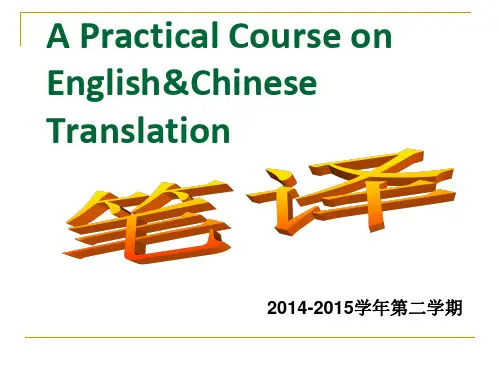

大学英语英汉翻译实践第一讲课后作业部分将下列段落译为汉语AttractionsManchester is a visitor's dream, bursting with interesting places to visit. Here, we list some of the city's leading attractions.Manchester is one of the most dynamic and lively places in Europe. A big city with a compact and friendly centre. A trendsetting music and style capital that still has a place for traditional street markets and local pubs. A place with an illustrious past that's always at the cutting edge of what's new.1.CulturalThe John Rylands LibraryRe-opened in May 2007 after a £16.8 million transformation, including improved access and visitor facilities, the John Rylands Library is definitely worth a visit. Experience the Gothic splendour of one of Manchester's most beautiful buildings and disco ver the library’s world famous collections through themed displays and hands-on activities. Enjoy a fascinating programme of exhibitions, talks and events throughout the year, relax in a brand new cafe and browse around the gift shop.2.Food and drinkCastlefieldBritain's first urban heritage park, Castlefield preserves Manchester's industrial legacy while offering visitors a picturesque canalside destination where they can eat, drink and have fun.Castlefield's mix of old and new is a winner with locals and visitors alike and its open spaces host festivals throughout the year.While the southern part of Castlefield is centred around water, the northern part is dominated by the Museum of Science and Industry in Manchester, another must-see attraction showcasing Manchester's industrial history.3.HistoryThe Imperial War MuseumDesigned by world-renowned architect Daniel Libeskind, the £28.5 million IWM North opened its doors in July 2002 and has since been blitzed with visitors.4.Art and cultureThe Lowry CentreRising like a futuristic ship at the heart of the redeveloped Salford Quays, The Lowry is a spectacular home to the arts and entertainment.5.ArtManchester Art GalleryRenowned for its prestigious collection of Pre-Raphaelite paintings, Manchester Art Gallery is one of the city's cultural gems.6.FootballOld TraffordMore than 200,000 people from all over the world visit Old Trafford every year to soak up the Manchester United experience and walk in the footsteps of George Best and the like.7.Historic houseTatton ParkIf the city gets a bit too much for you, escape to Tatton Park and take in its 1,000 acres of soothing scenery.8. Land's End Cornwall the most westerly point in mainland England. The most visited outdoor tourist attraction in the County. Lots for all the family to see and do. Land's End has rugged wave lashed cliffs, stunning views, the Longships Lighthouse and Wolf Rock off shore, the Isles of Scilly in the distance. 2500 miles away across the Atlantic Ocean is America. Land’s End.。
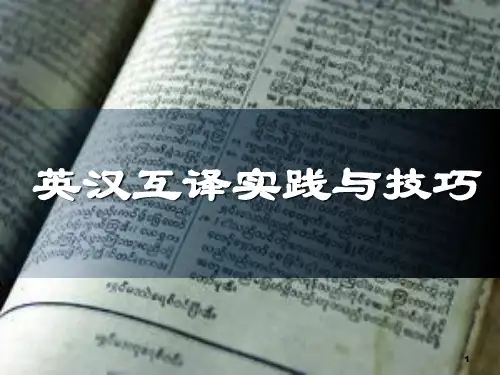


汉英翻译实践第一讲PART I:I. 原文(Source Text)水桥在巴拿马,有一座世界闻名的“水桥”,那就是巴拿马运河。
去年暑假,我跟着爸爸妈妈去巴拿马运河游览观光,至今还记忆犹新。
我们乘机抵达巴拿马城,然后搭上了一艘游轮,从巴尔博亚港进入运河。
船行13公里后,便到了运河的第一组水闸1。
巴拿马运河就是通过水闸的关与开,让船舰跨越陆地的一座“水桥” 2。
我们开始“上桥”了。
船驶进闸池之后,厚2米,高、宽各20米,重数百吨的钢闸门便缓缓地关闭,闸池里开始注水。
几分钟后,水涨船高3。
游轮在两岸电力机车的牵引下缓缓前进。
这样连升两级之后,船已经升高了16米。
出闸后,再驶过一个小湖,又到了第二组水闸。
经过这座水闸,船又升高了9.5米。
这样,船已高出海平面26米,进入“桥顶”4。
我们的游船驶进了长达13公里的主航道,只见5两岸山6如刀削,绿树红花,景色十分秀丽7。
游船出了峡谷,驶入了宽阔的加通湖。
湖水倒映着远山白云,美丽的小岛时隐时现8。
在湖中悠悠航行38公里之后,船来到了加通水闸,从此进入了“下桥”段。
这座水闸共有三级,犹如三个巨大的台阶。
游船经过加通水闸后,已经降到了与大西洋水面相同的高度。
当船驶入利蒙湾时,美丽的加勒比海便出现在眼前9。
我们从太平洋来到大西洋10,彼此隔离的大洋因为有了巴拿马运河而相通。
运河全长81.8公里,宽度由150米到304米不等。
5万吨级的巨轮,日夜畅通无阻。
它无愧于“世界桥梁”的称誉。
我由衷地赞美人类改造自然的智慧和勇气!我敬佩你,巴拿马人民!导游告诉我们,巴拿马人民是有志气的。
他们一方面正在改造现在这条运河;另一方面,还准备新建一条更长的运河,预计工程需要10年才能完成,它将成为人类有史以来最大的工程11。
我们期待着它早日完成。
II. 理解难点提示(Suggestions for Comprehension)1. 这里的“水闸”指什么?参考下文的“进闸池”、“出闸”。
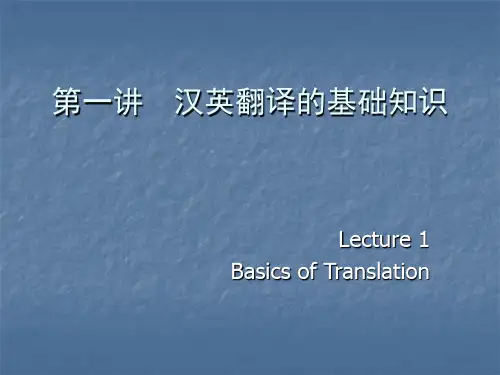
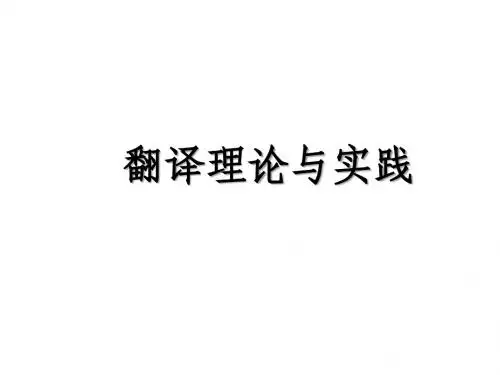


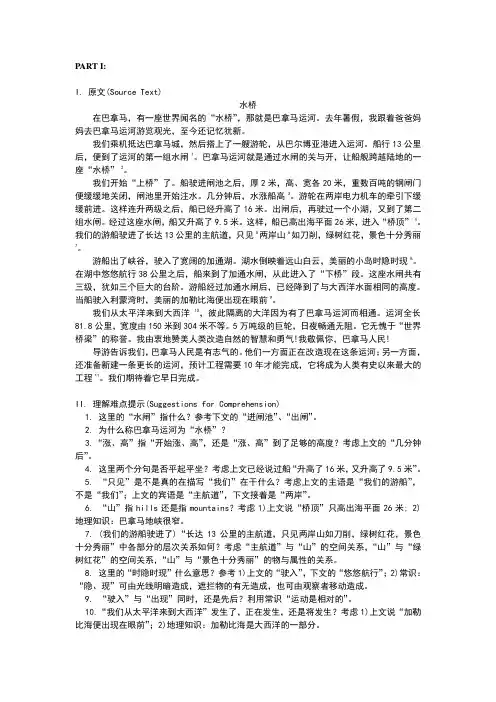
PART I:I. 原文(Source Text)水桥在巴拿马,有一座世界闻名的“水桥”,那就是巴拿马运河。
去年暑假,我跟着爸爸妈妈去巴拿马运河游览观光,至今还记忆犹新。
我们乘机抵达巴拿马城,然后搭上了一艘游轮,从巴尔博亚港进入运河。
船行13公里后,便到了运河的第一组水闸1。
巴拿马运河就是通过水闸的关与开,让船舰跨越陆地的一座“水桥” 2。
我们开始“上桥”了。
船驶进闸池之后,厚2米,高、宽各20米,重数百吨的钢闸门便缓缓地关闭,闸池里开始注水。
几分钟后,水涨船高3。
游轮在两岸电力机车的牵引下缓缓前进。
这样连升两级之后,船已经升高了16米。
出闸后,再驶过一个小湖,又到了第二组水闸。
经过这座水闸,船又升高了9.5米。
这样,船已高出海平面26米,进入“桥顶” 4。
我们的游船驶进了长达13公里的主航道,只见5两岸山6如刀削,绿树红花,景色十分秀丽7。
游船出了峡谷,驶入了宽阔的加通湖。
湖水倒映着远山白云,美丽的小岛时隐时现8。
在湖中悠悠航行38公里之后,船来到了加通水闸,从此进入了“下桥”段。
这座水闸共有三级,犹如三个巨大的台阶。
游船经过加通水闸后,已经降到了与大西洋水面相同的高度。
当船驶入利蒙湾时,美丽的加勒比海便出现在眼前9。
我们从太平洋来到大西洋10,彼此隔离的大洋因为有了巴拿马运河而相通。
运河全长81.8公里,宽度由150米到304米不等。
5万吨级的巨轮,日夜畅通无阻。
它无愧于“世界桥梁”的称誉。
我由衷地赞美人类改造自然的智慧和勇气!我敬佩你,巴拿马人民!导游告诉我们,巴拿马人民是有志气的。
他们一方面正在改造现在这条运河;另一方面,还准备新建一条更长的运河,预计工程需要10年才能完成,它将成为人类有史以来最大的工程11。
我们期待着它早日完成。
II. 理解难点提示(Suggestions for Comprehension)1. 这里的“水闸”指什么?参考下文的“进闸池”、“出闸”。
2. 为什么称巴拿马运河为“水桥”?3.“涨、高”指“开始涨、高”,还是“涨、高”到了足够的高度?考虑上文的“几分钟后”。
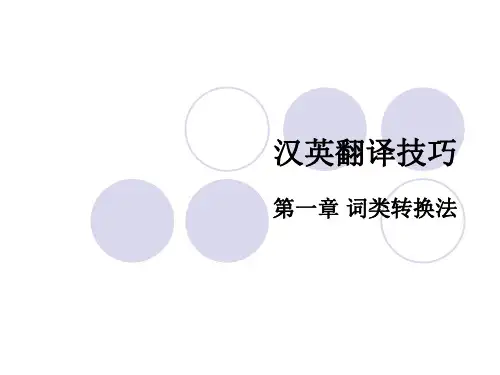
汉英翻译讲义第一章汉英翻译的过程:正确理解——充分表达——校核翻译时译者要牢记:1. The meaning of a sign is determined by the meanings of other signs.2. Each word when used in a new context is a new word.3. Words have no meanings, and people have meanings for them.1.1正确理解(Correct Comprehension) 理解原文要对原文进行语言分析、语境分析和逻辑分析等1.扑克牌打烂了。
2. 他的衣服穿烂了。
3. 走一步看一步。
4. 我银行里为你挂个名,你白天去走走,晚上教教我儿子,一面找机会,好不好?《围城》5. 海上花园海上仙山6. 国际旅游年7. 汉语茶话会8. 世界风云9. 半边天10. 中国留学服务中心11. 经济半小时12. 此复印件与原件相符。
1.2 充分表达(Adequate Representation)13. 虽败犹荣14. 特快专递15. 真好玩儿!16. 招贴即撕17. 减肥法18.中央电视台对外广播节目19. 他的节目不理想。
译文1:Her performance is not ideal.译文2:Her performance is ____________________________________.译文3:Her performance is ____________________.20. 他的英文水平比我高。
译文1:His English level is higher than mine.译文2:He ____________________________ than I (do).译文3:He ____________________________in English than I (am).21. 这山望见那山高。
Unit 1I. 英汉翻译原理第一讲:什么是翻译?【例1】The history of a tree from the time it starts in the forest until the boards which it yields are used, would form an interesting and, in manyinstances, an exciting story.(“×”号表示译文有问题,下同)×树的历史开始于森林中,直到生产为木板后被使用为止,成为一个有趣且有许多事例的激动人心的故事。
上面这句话的原文实际上主要说了两点内容:1、树的历史的起迄时间2、树的历史是怎样一回事【译文】一棵树,从它在森林中生长起直到被制成木板使用为止,这段历史会构成一个饶有趣味的故事,在很多情况下这个故事十分激动人心。
【例2】There are two regulatory systems which interact. One timing system comes from the evidence of our senses and stomachs, and the periodicitywe experience when living in a particular time zone.×有两个调节系统相互作用。
一个定时系统来自于我们的感官和胃的证明,就是当我们生活在一个特定的时区所经历的周期性。
【译文】人体有两个相互作用的时间调节系统。
一个时间调节系统依据感官和胃发出的信息,依据我们生活在某个时区所体验的周期性规律。
寻找对等词语和结构然后将其串接成句的翻译方法,常表现如下:1、简单语句的译文虽然生硬,但基本可读。
如:【例3】I can see three different types of composers in musical history, each of whom creates music in a somewhat different fashion.×我能看到音乐史上有三种不同的作曲家,他们中每一个人以某种不同的方式创作音乐。
Unit 1I. 英汉翻译原理第一讲:什么是翻译?【例1】The history of a tree from the time it starts in the forest until the boards which it yields are used, would form an interesting and, in manyinstances, an exciting story.(“×”号表示译文有问题,下同)×树的历史开始于森林中,直到生产为木板后被使用为止,成为一个有趣且有许多事例的激动人心的故事。
上面这句话的原文实际上主要说了两点内容:1、树的历史的起迄时间2、树的历史是怎样一回事【译文】一棵树,从它在森林中生长起直到被制成木板使用为止,这段历史会构成一个饶有趣味的故事,在很多情况下这个故事十分激动人心。
【例2】There are two regulatory systems which interact. One timing system comes from the evidence of our senses and stomachs, and the periodicitywe experience when living in a particular time zone.×有两个调节系统相互作用。
一个定时系统来自于我们的感官和胃的证明,就是当我们生活在一个特定的时区所经历的周期性。
【译文】人体有两个相互作用的时间调节系统。
一个时间调节系统依据感官和胃发出的信息,依据我们生活在某个时区所体验的周期性规律。
寻找对等词语和结构然后将其串接成句的翻译方法,常表现如下:1、简单语句的译文虽然生硬,但基本可读。
如:【例3】I can see three different types of composers in musical history, each of whom creates music in a somewhat different fashion.×我能看到音乐史上有三种不同的作曲家,他们中每一个人以某种不同的方式创作音乐。
PART I:I. 原文(Source Text)水桥在巴拿马,有一座世界闻名的“水桥”,那就是巴拿马运河。
去年暑假,我跟着爸爸妈妈去巴拿马运河游览观光,至今还记忆犹新。
我们乘机抵达巴拿马城,然后搭上了一艘游轮,从巴尔博亚港进入运河。
船行13公里后,便到了运河的第一组水闸1。
巴拿马运河就是通过水闸的关与开,让船舰跨越陆地的一座“水桥” 2。
我们开始“上桥”了。
船驶进闸池之后,厚2米,高、宽各20米,重数百吨的钢闸门便缓缓地关闭,闸池里开始注水。
几分钟后,水涨船高3。
游轮在两岸电力机车的牵引下缓缓前进。
这样连升两级之后,船已经升高了16米。
出闸后,再驶过一个小湖,又到了第二组水闸。
经过这座水闸,船又升高了9.5米。
这样,船已高出海平面26米,进入“桥顶” 4。
我们的游船驶进了长达13公里的主航道,只见5两岸山6如刀削,绿树红花,景色十分秀丽7。
游船出了峡谷,驶入了宽阔的加通湖。
湖水倒映着远山白云,美丽的小岛时隐时现8。
在湖中悠悠航行38公里之后,船来到了加通水闸,从此进入了“下桥”段。
这座水闸共有三级,犹如三个巨大的台阶。
游船经过加通水闸后,已经降到了与大西洋水面相同的高度。
当船驶入利蒙湾时,美丽的加勒比海便出现在眼前9。
我们从太平洋来到大西洋10,彼此隔离的大洋因为有了巴拿马运河而相通。
运河全长公里,宽度由150米到304米不等。
5万吨级的巨轮,日夜畅通无阻。
它无愧于“世界桥梁”的称誉。
我由衷地赞美人类改造自然的智慧和勇气!我敬佩你,巴拿马人民!导游告诉我们,巴拿马人民是有志气的。
他们一方面正在改造现在这条运河;另一方面,还准备新建一条更长的运河,预计工程需要10年才能完成,它将成为人类有史以来最大的工程11。
我们期待着它早日完成。
II. 理解难点提示(Suggestions for Comprehension)1. 这里的“水闸”指什么参考下文的“进闸池”、“出闸”。
2. 为什么称巴拿马运河为“水桥”3.“涨、高”指“开始涨、高”,还是“涨、高”到了足够的高度考虑上文的“几分钟后”。
4. 这里两个分句是否平起平坐考虑上文已经说过船“升高了16米,又升高了9.5米”。
5. “只见”是不是真的在描写“我们”在干什么考虑上文的主语是“我们的游船”,不是“我们”;上文的宾语是“主航道”,下文接着是“两岸”。
6. “山”指hills还是指mountains考虑1)上文说“桥顶”只高出海平面26米; 2)地理知识:巴拿马地峡很窄。
7. (我们的游船驶进了)“长达13公里的主航道,只见两岸山如刀削,绿树红花,景色十分秀丽”中各部分的层次关系如何考虑“主航道”与“山”的空间关系,“山”与“绿树红花”的空间关系,“山”与“景色十分秀丽”的物与属性的关系。
8. 这里的“时隐时现”什么意思参考1)上文的“驶入”,下文的“悠悠航行”;2)常识:“隐、现”可由光线明暗造成,遮拦物的有无造成,也可由观察者移动造成。
9. “驶入”与“出现”同时,还是先后利用常识“运动是相对的”。
10.“我们从太平洋来到大西洋”发生了,正在发生,还是将发生考虑1)上文说“加勒比海便出现在眼前”;2)地理知识:加勒比海是大西洋的一部分。
11. 这些话是不是作者的话1)上文说“导游告诉我们”; 2)作文知识:“巴拿马人民是有志气的”是论点,而论点需要论据。
III. 译文(Target Text)A Water BridgeAcross1 Panama runs2 a world-famous “water bridge”, and3 that is the Panama Canal. Last summer vacation I went with my parents on a sightseeing tour along it, which4 is still fresh in my memory.Having got5 to Panama City by air, we boarded a pleasure boat in the port of Balboa and sailed into the canal. The boat traveled 13 km and reached the first group of water locks. The Panama Canal is thus a “water bridge” that allows ships to cross land by the opening and closing of water locks.We began “getting onto the bridge”. When the boat had sailed into the lockchamber, the steel gate, 2 meters thick, 20 meters high and wide and hundreds of tons in weight, slowly closed, and water began running into the chamber, which continued for a few minutes6. The boat rose with the water and advanced slowly, pulled along by power cars along both banks. Two lifts like that raised the boat 16 meters7. It sailed out of the lock across a small lake and came to the second group of locks, which raised the boat another8 meters. In this way, the boat, now 26 meters above sea level, had got onto the “top of the bridge”. It sailed along the main channel, which stretched 13 km between beautiful hills as steep as if cut apart with a sword and covered with green trees and colorful flowers9.The boat sailed out of the gorge and into the wide Gatún Lake, with10 white clouds and distant hills reflected in it and pretty isles passing into and out of sight11. After a leisurely journey of 38 km on the lake12, the boat came to the Gatún Locks, and there began its “descent down the bridge”.The Gatún Locks, three in number, looked like so many13 gigantic steps. After getting14 through the locks, the boat had descended to the same level as the surface of the Atlantic Ocean. The beautiful Caribbean Sea came into view as it15sailed into the Limón Bay.We had come16 from the Pacific to the Atlantic, two great oceans separated by land but linked by the Panama Canal. The canal is 81.8 km in length and 150 to 304 m in width. Ships of 50,000 tons can pass it unimpeded all around the clock17. It is truly worthy of the name of “the Bridge of t he World”. Full of hearty praises18 am I for man’s wisdom and courage in transforming nature! I admire you, the people of Panama!The guide told us that the Panamanian people had high aspirations. On the one hand, they were19working to improve the existent canal, and on the other hand, they were planning for an even longer one, which20, it was estimated, would take 10 years to complete, and which21 would be the greatest project in man’s history. We look forward to its early completion22.IV. 表达讲解(Explanation of Expression)1. “在”译为across是由canal的形状与其同Panama的位置关系决定的。
这是具体化。
2. “有”译为runs,是由canal的形状决定的。
这也是具体化。
3. 原文中没有“和”(意合),译文里用and(形合)。
英语里不能单用逗号连接两个分句。
4. 原文没有主语,是承前省,译文用了which,既提供了主语,又与前面的分句连接起来了。
改为it或that只有前一种作用,没有后一种作用。
5. 原文的“我们”在全句之首,译文中句首没有we,条件是原文句首用非限定分句或无动词分句。
6. 原文“几分钟后”属下句,译文which continued for a few minutes属上句,但描写的是同一事实,只是观察角度不同(视点转换)。